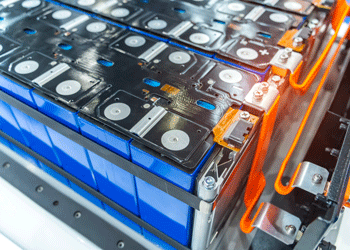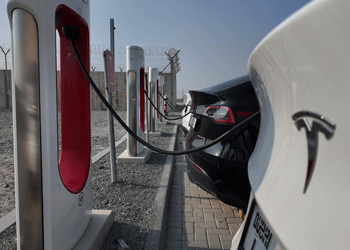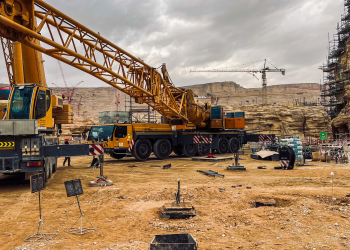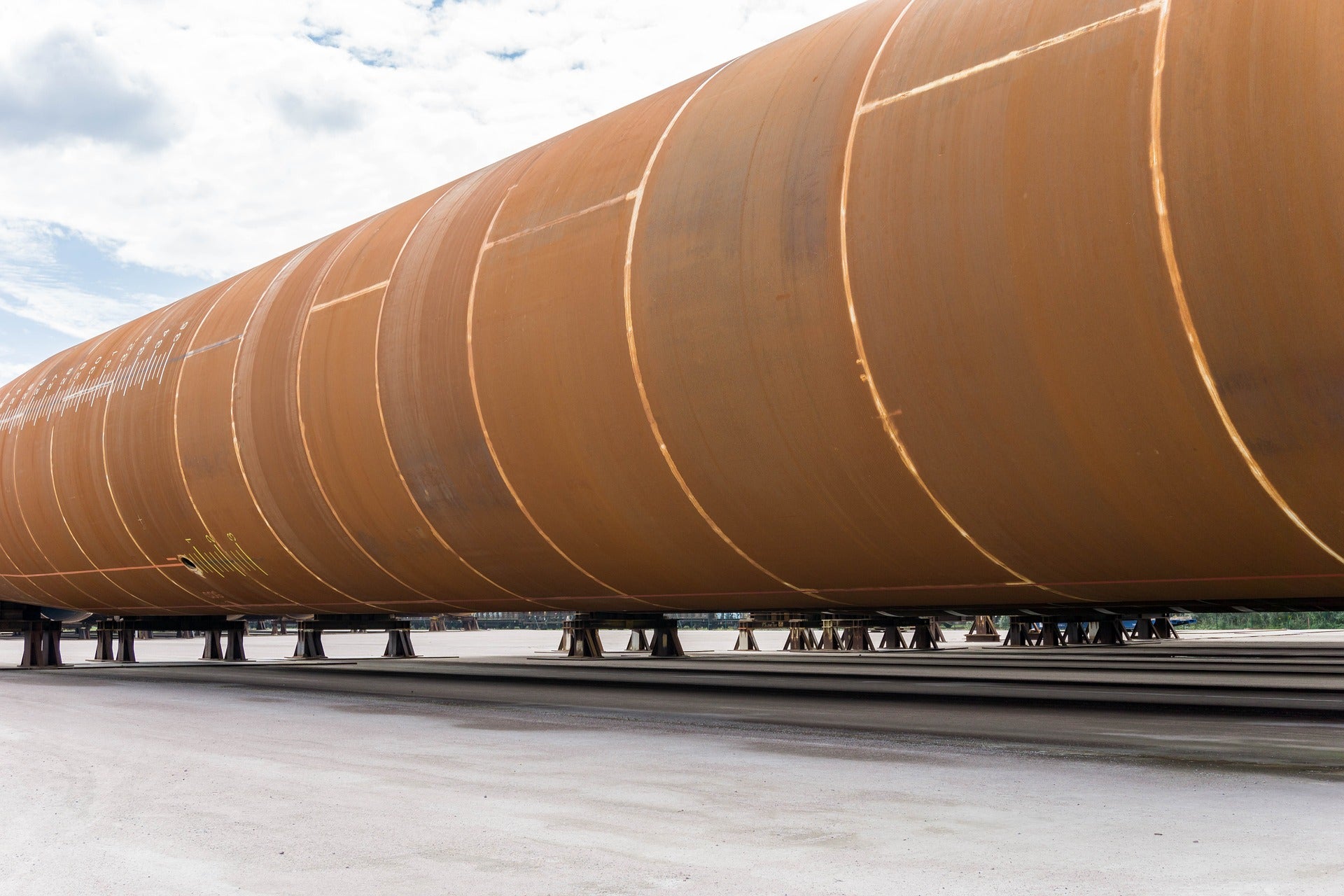Aramco awards $2bn-plus contract for Marjan offshore field
20 August 2024

Register for MEED's 14-day trial access
Saudi Aramco has awarded Italian contractor Saipem an estimated $2bn-2.5bn contract that involves the engineering, procurement, construction and installation (EPCI) works for several structures at the Marjan oil and gas field development in Saudi Arabia.
The contract award is for tender number 127 in Aramco’s Contracts Release and Purchase Order (CRPO) system. The scope of work entails EPCI works for the following structures at the Marjan offshore field development:
- Eight slipover jackets
- Three production deck modules
- Upgrade of auxiliary platforms
- Laying of subsea pipelines and cables spanning 166 kilometres
- Demolition of existing units
MEED previously reported that the contractors in Aramco’s Long-Term Agreement (LTA) pool of offshore service providers submitted technical bids and associated In-Kingdom Total Value Add (IKTVA) credentials for CRPO 127 by the 15 January deadline.
Offshore LTA contractors submitted commercial bids for CRPO 127 by 29 January.
The following contractors from Aramco’s LTA pool of offshore service providers are understood to have submitted bids for CRPO 127, according to sources:
- Lamprell (UAE/Saudi Arabia)
- Larsen & Toubro Energy Hydrocarbon (India)/Subsea 7 (UK)
- NMDC Energy (UAE)
- Saipem (Italy)
Aramco, eventually, in late June, requested LTA contractors to extend the validity of their bids for CRPO 127, along with five other offshore tenders, until the end of July. Contractors were then asked to extend the bid validity for these tenders until 9 September, sources told MEED.
Robust offshore spending
In late January, the Saudi energy ministry directed Aramco to abandon its campaign to expand its oil production spare capacity from 12 million barrels a day (b/d) to 13 million b/d by 2027. As a direct consequence of that government instruction, Aramco cancelled the tendering process for at least 15 CRPO jobs involving the EPCI of structures at key offshore oil fields, MEED previously reported.
Since that decision, however, Aramco has gone the other way. The Saudi energy giant has already spent an estimated $4-4.5bn on offshore EPCI contracts year-to-date, all of which have been awarded to Saipem.
ALSO READ: Aramco increases spending despite drop in profits
Before awarding CRPO 127 to Saipem, Aramco had awarded CRPOs 132 and 139 to the Italian contractor. Their combined value is estimated to be over $1bn. The scope of work on CRPOs 132 and 139 involves installing and upgrading structures at the Marjan and Zuluf offshore field developments, respectively.
Prior to those contracts, Aramco awarded Saipem the contract for CRPO 138, which involves laying a trunkline at the Abu Safah offshore field in Saudi Arabia. The contract is estimated to be worth $500m.
In early May, MEED reported that Aramco had awarded Saipem the contract for CRPO 143, which involves replacing an oil line between the Berri and Manifa oil fields in the kingdom’s Gulf waters.
Separately, in May, Aramco issued four tenders to its LTA contractors as part of a project to further expand the Zuluf offshore field development. The main objective of the project is to install multiple structures at the Zuluf field to maintain and raise its long-term oil and gas production potential.
Sources told MEED that the combined value of CRPOs 145, 146, 147 and 148 is estimated to be around $4bn. LTA contractors were initially due to submit bids for the four tenders by 22 August, but Aramco recently extended the deadline until 17 October.
ALSO READ: Aramco CEO expects capex to grow in 2025
Exclusive from Meed
-
 Batteries shape the region’s energy future
Batteries shape the region’s energy future18 December 2025
-
 Middle East drives electric vehicle revolution
Middle East drives electric vehicle revolution18 December 2025
-
 Key technology themes poised to shape 2026
Key technology themes poised to shape 202618 December 2025
-
 Qiddiya tenders Janadriyah cultural district hotels
Qiddiya tenders Janadriyah cultural district hotels18 December 2025
-
 Iraq-Turkiye pipeline exporting around 212,000 b/d of oil
Iraq-Turkiye pipeline exporting around 212,000 b/d of oil18 December 2025
All of this is only 1% of what MEED.com has to offer
Subscribe now and unlock all the 153,671 articles on MEED.com
- All the latest news, data, and market intelligence across MENA at your fingerprints
- First-hand updates and inside information on projects, clients and competitors that matter to you
- 20 years' archive of information, data, and news for you to access at your convenience
- Strategize to succeed and minimise risks with timely analysis of current and future market trends

Related Articles
-
 Batteries shape the region’s energy future
Batteries shape the region’s energy future18 December 2025

This package also includes:
> TECH THEMES: Key technology themes poised to shape 2026
> EVs: Middle East drives electric vehicle revolution
Batteries, having progressed from enabling consumer electronics to powering the first wave of electric vehicles (EVs), are now poised to become one of the world’s most significant industrial and geopolitical forces in the next decade, says GlobalData’s Strategic Intelligence platform.
According to a recently published report, this progress is due to stored energy’s accelerating and expanding role in mitigating climate change.
For the Middle East, a region defined by its energy leadership and major economic diversification strategies, the battery revolution presents not just a commercial opportunity, but a strategic imperative focused on securing key components of the new global supply chain. The region’s success in the coming years will be judged by its ability to navigate the raw material shortages, geopolitical rivalries and technological shifts that define the market.
The cornerstone of this theme is the soaring demand for cheap, safe and high-performance batteries, driven predominantly by the automotive sector, which is forecast to account for over 80% of aggregate battery demand between now and 2035.
Industry growth
Global lithium-ion battery industry revenues are forecast to surge to over $408bn by 2035, up from $88.6bn in 2022.
This growth is spurring industrial expansion, with the global transition to EVs requiring an accompanying build-out of battery gigafactories. While China currently dominates this landscape, accounting for 77% of EV gigafactories in 2022, Europe and North America are taking steps to reduce their dependence on Chinese supply chains by 2030, driven by the US Inflation Reduction Act and European ambition.
This geopolitical tension directly impacts the Middle East’s emerging industrial strategy. The need for regionalised supply chains is critical, and North Africa has already taken a step towards this with Chinese investment establishing a battery gigafactory in Morocco, aimed at supplying the European market.
Furthermore, Gulf nations are exploring direct investment in manufacturing capability, demonstrated by the Statevolt plan to build a $3.2bn gigafactory in the UAE’s northern emirate of Ras Al-Khaimah, specialising in advanced battery cells.
These efforts are essential to integrating the Middle East into the global manufacturing network, leveraging its geographical position between the major consuming markets of Europe and Asia.
Beyond manufacturing, the most significant threat to the industry is the impending shortage of low-cost, easy-to-purify raw materials like lithium, cobalt and nickel, which is largely due to a lack of investment in new mines over the past five years.
Lithium extraction, in particular, requires significant investment to meet the growing demand. This crunch has been exacerbated by China’s control over the entire supply chain, from the mines to the refining of critical battery metals.
This situation is as much an environmental and geopolitical concern as it is an economic one, necessitating a shift towards a circular battery economy. The region, therefore, has an immediate need to invest in recycling facilities to offset near-term supply shortages, securing local access to processed materials for its emerging domestic battery production capabilities.
Green hydrogen capacity in the region is projected to grow at a compound annual growth rate of nearly 150% in 2025-30
Clean energy edge
The Middle East’s position as a source of clean energy and a major energy exporter makes the deployment of hydrogen fuel cells a crucial complementary theme. Hydrogen has been championed for decades as a clean fuel, and a UN-sponsored Green Hydrogen Catapult Initiative, involving Saudi and European founding partners, aims to scale up green energy production.
The Middle East is pursuing this with projects like Dubai’s Green Hydrogen project, which uses solar power to produce hydrogen, signalling the region’s intention to be a major player in clean fuel production.
Though hydrogen is unlikely to power small vehicles like cars, its future dominance is expected in heavy industrial processes and heavy transport, such as lorries, trains, ships and planes, making it highly relevant to the Gulf’s core logistics and industrial sectors.
Green hydrogen capacity in the region is projected to grow at a compound annual growth rate of nearly 150% in 2025-30, although this starts from a low base.
Finally, the shift towards battery-powered EVs appears to be gaining regional momentum. Although EV adoption in the Middle East is still in its early stages – with the UAE leading with just a 3% penetration of new car sales – projections show EVs could account for as much as 64% of the new car market by 2035. The transition is supported by major investment in charging infrastructure and a market poised to be worth tens of billions of dollars.
Impending consumer demand will be a primary driver for the strategic battery manufacturing and hydrogen production investments now being made by policymakers and industrial leaders in the GCC. The confluence of these factors – securing the raw materials, establishing domestic manufacturing and deploying complementary clean fuels like hydrogen – will be central to the Middle East’s role in the global energy transition over the next decade.
https://image.digitalinsightresearch.in/uploads/NewsArticle/15278484/main.gif -
 Middle East drives electric vehicle revolution
Middle East drives electric vehicle revolution18 December 2025

This package also includes:
> TECH THEMES: Key technology themes poised to shape 2026
> BATTERIES: Batteries shape the region's energy future
The global automotive landscape is undergoing a seismic shift as electric vehicles (EVs) become increasingly central to the industry’s future, according to GlobalData’s Strategic Intelligence platform.
This is not just a technological evolution but a geopolitical one, with the Middle East poised to play a pivotal role. The region, traditionally known for its oil reserves, is now at the forefront of the EV revolution, driven by strategic investments, policy shifts and a commitment to sustainability.
In recent years, the Middle East has witnessed a surge in initiatives aimed at fostering the growth of EVs. Governments across the region are implementing policies to encourage EV adoption, recognising the dual benefits of reducing carbon emissions and diversifying their economies away from oil dependency.
The UAE, for example, has set ambitious targets to increase the number of EVs on its roads, supported by substantial investments in charging infrastructure and incentives for EV buyers.
The strategic location of the Middle East, bridging Europe, Asia and Africa, provides a unique advantage in the global EV supply chain. This geographical positioning allows the region to serve as a critical hub for the distribution and manufacturing of EVs and their components. Countries like Saudi Arabia are capitalising on this by investing in local manufacturing capabilities, aiming to become leaders in the production of EVs and related technologies.
The Middle East’s abundant natural resources, particularly in minerals essential for battery production, position it as a key player in the EV market. The region’s focus on developing a sustainable supply chain for these materials is crucial, as the global demand for batteries continues to rise. This strategic move not only supports the local economy but also strengthens the region’s influence in the global automotive industry.
The shift towards EVs in the Middle East is also driven by a broader commitment to sustainability and climate goals. The region’s governments are increasingly aligning their policies with international environmental standards, recognising the
importance of transitioning to cleaner energy sources. This alignment is reflected in the growing number of partnerships between Middle Eastern countries and leading global automotive companies, aimed at accelerating the development and deployment of EV technologies.Despite the challenges, momentum towards EVs in the Middle East remains positive
Tackling challenges
The transition is not without its challenges. The Middle East faces significant hurdles in terms of infrastructure development and consumer acceptance.
The establishment of a comprehensive charging network is critical to support the widespread adoption of EVs. Additionally, changing consumer perceptions and encouraging the shift from traditional combustion engines to EVs requires concerted efforts on the part of both the public and the private sector.
Despite the challenges, the momentum towards EVs in the Middle East remains positive. The region-wide commitment to innovation and sustainability is evident in the proactive approach to addressing these issues. By investing in research and development, fostering international collaborations and implementing forward-thinking policies, the Middle East is positioning
itself as a leader in the global transition to EVs.As the world moves towards a more sustainable future, the region’s efforts to embrace EVs will not only transform its own transportation landscape, but also contribute significantly to global environmental goals.
The Middle East’s journey towards becoming a central player in the EV market is a compelling narrative of change, resilience and forward-thinking leadership.
https://image.digitalinsightresearch.in/uploads/NewsArticle/15277963/main.gif -
 Key technology themes poised to shape 2026
Key technology themes poised to shape 202618 December 2025

This package also includes:
> EVs: Middle East drives electric vehicle revolution
> BATTERIES: Batteries shape the region's energy future
The technological landscape in 2026 is poised for transformative shifts that promise to redefine industries and reshape societal norms.
The predictions for the coming year, as outlined in the Tech Predictions 2026 report published by UK analytics firm GlobalData’s Strategic Intelligence unit, highlight several areas where technology will make significant strides, from the Internet of Things (IoT) to artificial intelligence (AI), and from robotics to the future of mobility.
These advancements are not just incremental; they represent a paradigm shift in how technology integrates with and enhances human life.
Anticipated advances
The IoT is set to become an even more integral part of our daily lives, with the market expected to surpass $1.4tn by 2026. This growth is driven by advancements in wireless technologies, such as 5G and satellite networks, which will enhance connectivity and enable IoT devices to operate in remote locations.
The integration of AI into IoT, known as AIoT, will further revolutionise the field by enabling automated operations and predictive maintenance.
Security concerns remain a significant hurdle, as the fragmented security standards landscape poses risks to IoT deployments. The challenge lies in creating robust security frameworks that can protect vast networks of interconnected devices from cyber threats, ensuring that the benefits of IoT are not overshadowed by vulnerabilities.
In the realm of AI, 2026 will witness the expansion of the agentic AI ecosystem. This new phase of AI development involves AI agents capable of autonomous decision-making, which will be utilised across various sectors.
Despite the potential of these technologies, the adoption of AI tools in enterprises will be tempered by uncertainties regarding their business value. Nonetheless, AI’s influence is undeniable, with its applications ranging from enhancing workplace productivity to transforming the gaming industry.
The ethical implications of AI, particularly in terms of decision-making and data privacy, will continue to be a topic of debate. As AI systems become more autonomous, the need for transparent algorithms and accountability mechanisms becomes increasingly critical.
Robotics, too, is on the brink of a new era, fuelled by advancements in AI and cloud computing. These technologies will unlock new use cases for robots, particularly in service settings where they can assist humans in non-industrial environments.
The interest in humanoid robots is also expected to grow, driven by their potential to address labour shortages and perform tasks in hazardous environments. As major tech companies seek to expand their stake in the robotics industry, we can anticipate a wave of acquisitions and mergers.
The integration of robots into everyday life will raise questions about the future of work and the role of humans in an increasingly automated world. While robots can enhance efficiency and safety, there is a need to address the socioeconomic impacts of automation, particularly in terms of employment and skill development.
The adoption of AI tools in enterprises will be tempered by uncertainties regarding their business value
Driving change
The future of mobility is another area where significant changes are anticipated. Expected to be a pivotal year for the adoption of robotaxis, in 2026 pilot projects will transition to commercial rollouts. This shift is facilitated by the collaboration between technology developers, ride-hailing platforms and regulators, which lowers the barriers to entry.
The electric vehicle market in North America is predicted to plateau, hindered by policy uncertainties and the expiration of key federal tax credits.
The development of autonomous vehicles will also necessitate advancements in infrastructure, such as smart roads and traffic management systems, to ensure safety and efficiency. Moreover, the environmental impact of increased vehicle automation and electrification will be a critical consideration, as the world grapples with the challenges of climate change.
In the space economy, the market is projected to reach $453.9bn in 2026, driven by advances in communications and navigation technologies. The deployment of low Earth orbit satellite constellations will continue to enhance global connectivity, providing significant downstream capacity.
The convergence of space and quantum technologies is also on the horizon, with quantum sensing and cryptography being integrated into space-borne systems. This integration will open new frontiers in space exploration and security, offering unprecedented opportunities for scientific discovery and commercial ventures.
The militarisation of space and the potential for conflicts over space resources will require careful international cooperation and regulation.
Streaming platforms, meanwhile, will face a profitability crunch as the market becomes increasingly saturated. To survive, platforms will need to consolidate and focus on dual content strategies that cater to both global and local audiences.
AI will play a crucial role in this transformation, enabling platforms to personalise content and streamline production processes. The competition for viewer attention will drive innovation in content delivery and user engagement, with immersive technologies such as virtual reality and augmented reality offering new ways to experience media.
The ethical implications of AI-driven content curation, particularly in terms of bias and misinformation, will need to be addressed to maintain trust and integrity in digital media.
Positive outlook
As we look to 2026, it is clear that technology will continue to be a driving force in shaping the future. Advancements in IoT, AI, robotics and mobility, among others, will not only transform industries but also redefine how we interact with the world around us.
However, these developments also bring challenges, particularly in terms of security, regulation and ethical considerations. As such, it is imperative for stakeholders to navigate these changes with a balanced and considered approach, realising the benefits while mitigating potential risks.
The journey in 2026 is not just about technological innovation; it is about harnessing these advancements to create a more connected, efficient and sustainable world. As we embrace the possibilities of the future, we must also remain vigilant about the challenges that lie ahead, ensuring that technology serves humanity and not the other way around. The path forward will require collaboration, foresight and a commitment to ethical principles, as we strive to build a future that is inclusive, equitable and resilient.
https://image.digitalinsightresearch.in/uploads/NewsArticle/15277938/main.gif -
 Qiddiya tenders Janadriyah cultural district hotels
Qiddiya tenders Janadriyah cultural district hotels18 December 2025
Saudi gigaproject developer Qiddiya Investment Company (QIC) has issued a tender inviting firms to bid for a contract to build two hotels at the Janadriyah cultural district.
The tender was issued on 11 December. Technical bids are due on 29 January, and the commercial bid submission deadline is 19 February.
The package comprises the construction of the Wadi Hotel and the Gateway Hotel.
Firms are also bidding for the Janadriyah cultural district main works. The tender for this package was issued in November.
QIC is expected to receive bids for this package by 30 December.
QIC is accelerating plans to develop additional assets at Qiddiya City.
In December, MEED exclusively reported that QIC is expected to float a tender soon for the construction of the estimated SR7bn ($1.8bn) National Athletics Stadium at its Qiddiya entertainment city development.
MEED understands that the prequalification process has reached an advanced stage and the tender for the main contract is likely to be issued within a few weeks.
The multipurpose stadium will cover an area of approximately 182,000 square metres and its design is inspired by the London Olympic Stadium.
Firms are bidding for a SR980m ($261m) contract covering the construction of staff accommodation. Earlier in December, MEED exclusively reported that QIC has allowed firms until 8 January to submit their bids.
The tendering follows QIC’s October announcement that it had awarded a SR5.2bn ($1.4bn) construction contract to build the performing arts centre at Qiddiya Entertainment City.
The centre will have over 3,000 seats across three theatres. It will also include a cantilevered amphitheatre overlooking Qiddiya City’s lower plateau, with a 500-seat centre suspended from above.
The Qiddiya City performing arts centre is one of several major projects within the greater Qiddiya development. Other projects include an e-games arena, the Prince Mohammed Bin Salman Stadium, a motorsports track, the Dragon Ball and Six Flags theme parks, and Aquarabia.
The project is a key part of Riyadh’s strategy to boost leisure tourism in the kingdom. According to GlobalData, leisure tourism in Saudi Arabia has experienced significant growth in recent years.
https://image.digitalinsightresearch.in/uploads/NewsArticle/15277573/main.jpg -
 Iraq-Turkiye pipeline exporting around 212,000 b/d of oil
Iraq-Turkiye pipeline exporting around 212,000 b/d of oil18 December 2025

The Iraq-Turkiye Pipeline (ITP) is currently exporting around 212,000 barrels of oil a day (b/d), according to industry sources.
Before the 2023 shutdown, the pipeline was transporting about 450,000-500,000 b/d of crude.
One source said: “Some thought that by now the export flows through the pipeline would be higher, but a lack of drilling at oil fields in Iraqi Kurdistan during the shutdown has led to a decline in pumping capacity.”
On 27 September, oil flows restarted from Iraqi Kurdistan to the Turkish port of Ceyhan via the ITP.
The restart followed an agreement between oil companies operating in Iraqi Kurdistan, the Iraqi federal government in Baghdad and the Kurdistan Regional Government (KRG).
Under the terms of the deal, the KRG is delivering the crude to Iraq’s state-owned oil marketing company, Somo, and an independent trader is handling sales from the Turkish port of Ceyhan using Somo’s official prices.
Research and consultancy firm Wood Mackenzie is preparing a report that will help determine the prices oil-producing companies receive.
Eight oil producers have agreed to accept a temporary price of $16 a barrel until the Wood Mackenzie review is completed.
The final review is expected to lead to a retroactive adjustment of payments.
The initial shutdown of the ITP started in March 2023, when the International Chamber of Commerce ordered Turkiye to pay Iraq $1.5bn in damages for what it decided were unauthorised exports by the Kurdish regional authorities.
Turkiye has stated that it plans to continue its appeal against this compensation order.
https://image.digitalinsightresearch.in/uploads/NewsArticle/15274411/main.jpg


